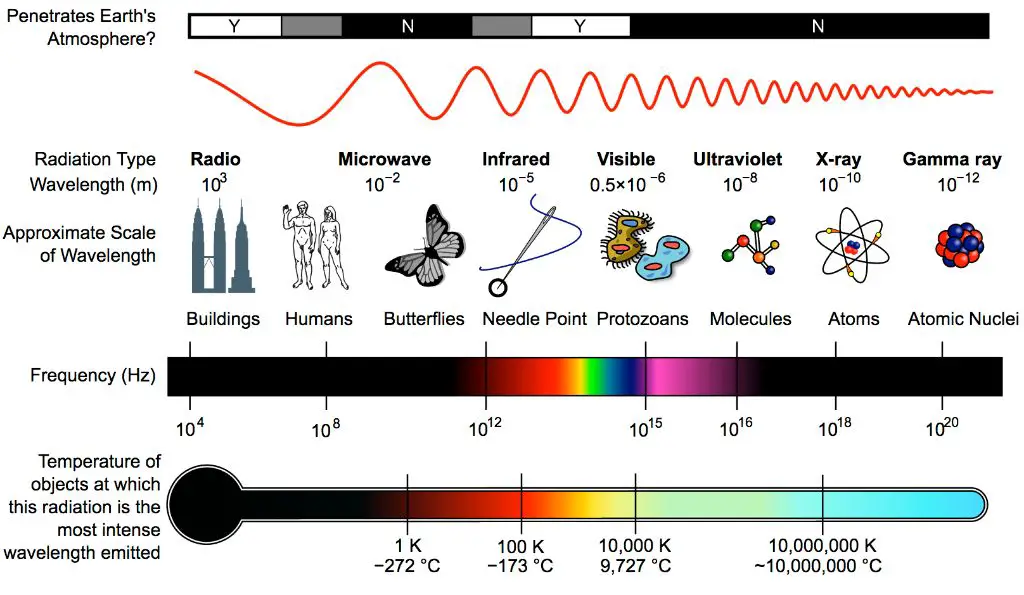What Is Light And Its Properties?
Light is a form of electromagnetic radiation that is visible to the human eye. It plays a central role in our daily lives and in the universe at large. Light allows us to see the world around us. It is crucial for photosynthesis in plants and provides energy that supports life on Earth. Beyond Earth, light from celestial objects like stars and galaxies gives insight into the nature, origin, and evolution of the cosmos.
Light has both wave-like and particle-like properties. As a wave, it can be characterized by wavelength, frequency, and amplitude. As particles called photons, light exhibits properties of discreteness and quantization. Light interacts with matter in complex ways, being reflected, refracted, diffracted, scattered, absorbed, or emitted when encountering objects. The visible spectrum of light that humans see represents only a tiny sliver of the entire electromagnetic spectrum, which ranges from radio waves to gamma rays.
Understanding the nature of light has been an important quest in physics for centuries. From ancient Greek philosophers to quantum pioneers like Max Planck, investigations into light have repeatedly led to fundamental insights about the workings of nature. The study of light continues to enable advances in diverse disciplines like astronomy, engineering, medicine, communications, and more. This overview will explore some of the most important properties and behaviors of this ubiquitous yet still mysterious phenomenon called light.
The Electromagnetic Spectrum
Light is a form of electromagnetic radiation that is part of the electromagnetic spectrum. The electromagnetic spectrum encompasses all electromagnetic waves, ordered according to increasing frequency and decreasing wavelength. The electromagnetic waves with the lowest frequencies and longest wavelengths are radio waves. As you move up the spectrum, the waves have progressively higher frequencies and shorter wavelengths, going from microwaves to infrared, visible light, ultraviolet, x-rays, and finally gamma rays which have the highest frequencies and shortest wavelengths.

Visible light that is detectable by human eyes makes up only a small portion of the electromagnetic spectrum. Visible light wavelengths range from about 380 nanometers to about 740 nanometers. The color of visible light depends on its wavelength. Red light has the longest visible wavelengths while violet light has the shortest. When all the wavelengths of visible light are combined together, they make white light.
The wavelength and frequency of light are related by the speed of light constant, which is roughly 3 x 108 meters per second. As wavelength increases, frequency decreases and vice versa. Radio waves, microwaves and infrared waves have longer wavelengths and lower frequencies compared to visible light. Ultraviolet, x-rays and gamma rays have shorter wavelengths and higher frequencies than visible light.
Speed of Light
The speed of light in a vacuum is a fundamental constant of nature that has profound implications on our understanding of space and time. Light always travels at the same speed, approximately 300,000 kilometers per second or 186,000 miles per second. This constant speed is referred to as the speed of light and given the symbol c.
The realization that the speed of light is constant underlies one of the most revolutionary scientific theories in history – Albert Einstein’s theory of special relativity. Prior to Einstein, it was thought that the speed of light traveled through some medium called the luminiferous ether, and that its speed would vary depending on the motion of the light source relative to the ether. However, experiments designed to measure deviations in the speed of light were unable to detect any variation, leading Einstein to propose that the speed of light is constant regardless of the motion of the source.
Einstein elevated the constancy of the speed of light to a fundamental postulate of the special theory of relativity. From this postulate, Einstein derived startling conclusions about the nature of space and time, showing that distance and duration are not absolute but dependent on the motion of the observer. Time and space were unified into spacetime, and the absolutes of Newtonian physics were replaced with the relativity of motion.
The constant speed of light also arises from Maxwell’s equations of electromagnetism developed in the 19th century. These equations relate the electric and magnetic fields to each other and to electric charges and currents. Solving these equations results in wave solutions that travel at a fixed speed determined by the electromagnetic properties of the vacuum. This predicted speed matches the measured speed of light, indicating that light consists of propagating electromagnetic waves.
The speed of light sets the limit for cause and effect in the universe, with no information or influence able to travel faster than light. It is one of the most important and precisely tested principles in all of physics.
Reflection
Reflection is when light bounces off a surface. The law of reflection states that the angle of incidence equals the angle of reflection. This means that when a beam of light hits a reflective surface like a mirror, it bounces off at the same angle as it arrived. For example, if a light beam hits a mirror at a 30° angle, it will reflect off the mirror at a 30° angle on the other side of the perpendicular line. The reflective properties of mirrors make them useful for seeing around corners or for personal grooming.
Reflection happens whenever light moves from one medium to another. When light hits an object, it can be either absorbed, transmitted through, or reflected. Smooth or polished surfaces like mirrors reflect much of the light that falls on them. Rough surfaces reflect light scattered in many directions. Reflection allows us to see non-luminous objects. Most of the objects we see around us are visible to us because of reflected light.
Examples of reflection in everyday life include rearview mirrors, shiny metallic surfaces like silver or chrome, reflections in glass buildings or windows, and reflections in bodies of water. Reflection is an important concept for understanding how light interacts with different materials and allows us to see the world around us.
Refraction
Refraction refers to the bending of light when it passes from one medium to another. This occurs because light travels at different speeds in different media. As light enters a new medium at an angle, one side of the wavefront slows down before the other side, changing the direction of the wavefront.
The degree to which light bends depends on the refractive indices of the two media. The refractive index (n) is a measure of how much the speed of light is reduced in a material. Light bends towards the normal when entering a medium with a higher refractive index.
The relationship between the angles and refractive indices of the media is described by Snell’s law:
n1 * sin(θ1) = n2 * sin(θ2)
Where θ1 is the angle in the initial medium, θ2 is the angle in the second medium, n1 is the initial refractive index, and n2 is the second refractive index.
Refraction causes dispersion, which is the separation of white light into its component colors. This occurs because the refractive index varies slightly with wavelength, bending shorter wavelengths (violet) more than longer wavelengths (red). Prisms work by refracting light as it enters and exits the prism, separating white light into a rainbow spectrum.
Diffraction
Diffraction is the bending and spreading of waves when they encounter an obstruction or pass through an opening. It is caused by the wave nature of light. When light hits an obstacle or passes through a narrow slit, it spreads out on the other side. This causes the light waves to interfere with each other, producing effects like light and dark bands.
One of the key principles that describes diffraction is Huygens’ principle, proposed by Dutch physicist Christiaan Huygens in the 17th century. It states that every point on a wavefront can be considered a new source of wavelets that spread out in the forward direction at the same speed as the original wave. The new wavefront is the sum of all these secondary wavelets. This principle helps explain phenomena like diffraction, where an obstructed wavefront seems to bend around corners.
Single and double slit diffraction are common diffraction experiments. When light passes through a single narrow slit, a diffraction pattern of bright and dark lines is formed on a screen behind the slit. This occurs because the slit causes the waves to spread out, interfere, and diffract. If there are two parallel slits, the waves from each slit overlap and interfere, creating a more complex interference pattern of alternating bright and dark bands. The spacing and intensities of the bands depends on parameters like slit width and the wavelength of light.
Diffraction demonstrates that light propagates as waves. It also illustrates the wave nature of matter, since the same diffraction effects occur for particles like electrons. Diffraction is exploited in various optical instruments and analysis techniques to obtain information about light waves and material structures on the scale of wavelengths. The diffraction patterns reveal details too small to be resolved by regular imaging.
Interference
Interference is the phenomenon that occurs when two or more waves overlap. Interference can be constructive or destructive, depending on how the waves combine.
The principle behind interference is superposition. This states that when two or more waves overlap, the resulting displacement at any point is equal to the sum of the displacements of the individual waves. For example, if a wave with amplitude 1 unit overlaps a wave with amplitude 2 units, the resulting wave will have amplitude 3 units where the waves constructively interfere and 1 unit where they destructively interfere.
Constructive interference occurs when the wave peaks or troughs of the overlapping waves align, reinforcing each other. This results in a wave with increased amplitude. Destructive interference occurs when the peak of one wave overlaps with the trough of another, cancelling each other out. This results in a wave with decreased amplitude.
Some examples of interference in everyday life include the ripple patterns on the surface of water and the colorful patterns seen in soap bubbles or oil slicks. These arise from constructive and destructive interference of reflected and refracted light waves.
Interference effects are very important in many optical instruments and technologies. For example, interference filters use constructive and destructive interference to selectively transmit or reflect certain wavelengths of light.
Polarization
Polarization refers to the orientation of the oscillations in a transverse wave. Light and other electromagnetic waves are transverse waves, meaning the oscillations occur perpendicular to the direction of energy propagation.
The polarization of light is described by specifying the direction of the wave’s electric field. For example, in linear polarization the electric field oscillates in a single plane. The direction of this oscillation is called the polarization direction.
Light can also exhibit circular or elliptical polarization, where the electric field vector traces out a circle or ellipse in the plane perpendicular to the direction of propagation. Circularly polarized light can spin in a left-handed or right-handed direction as it travels.
Polarization is a useful property of light that can be manipulated with various optical devices. Polarizing filters allow light with matching polarization to pass through while blocking orthogonal polarization directions. These filters are used in photography, LCD displays, and more. Polarization can also be used to probe surface properties, stress in transparent materials, and help distinguish information in scattering environments.
Color
Color is a key property of light that arises from the visible spectrum. The visible spectrum is the portion of the electromagnetic spectrum that is visible to the human eye.
When all the colors of light are combined, they make white light. Objects appear to have different colors based on which wavelengths they absorb and reflect. For example, a red object absorbs all wavelengths except red light, which it reflects to our eyes.
There are three primary colors – red, blue and green. By mixing the primary colors, we can create the secondary colors:
- Red + Blue = Purple
- Red + Green = Yellow
- Blue + Green = Cyan
We can also create different hues by mixing colors. Adding white to a color makes it lighter or tinted, while adding black makes it darker or shaded.
Quantum Properties
Light also exhibits properties of particles called photons. A photon is a discrete packet or quantum of electromagnetic energy. The energy of a photon is directly proportional to its frequency according to Planck’s equation:
E = hf
Where h is Planck’s constant and f is the frequency of the photon. This demonstrates the particle nature of light.
Light also displays wave-particle duality, meaning it exhibits properties of both waves and particles. The photoelectric effect provided direct evidence of the particle nature of light. When light strikes certain metals, electrons are ejected. The energy of the ejected electrons depends on the frequency, not the intensity, of the light. This could only be explained by light consisting of discrete packets or photons.
Wave-particle duality is a fundamental concept in quantum mechanics. Light sometimes behaves as a continuous wave and other times as discrete particles depending on the experimental conditions. The wave and particle natures are not contradictory but represent different aspects of light.



